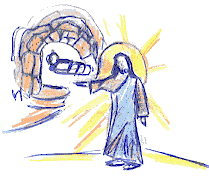


From the beginning of his teachings to this step Christ redefined all those levels of the human beingwith which the ancient mystic schools had been struggling for thousands of years. This enabled the "super-conscious" inner self to manifest itself in the life of the body, the psyche and the mind of every human being who follows the way. On the other hand, the ability to clear, to integrate, and to expand increasingly deeper and older parts of the subconscious becomes increasingly apparent.
The ancient Egyptian mysteries knew a path from the mind and psyche down to consciously taking up the physical will to live. With the "raising of Lazarus from the dead" - John 10.39 - 11 - another "deepening" appears. First of all, some details are obviously similar to that Egyptian knowledge. This concerned an old practice where the human being spent three days in a state known in modern parapsychology as an "Out-Of-Body-Experience", just like in a dream of flight, but consciously. The body lay there, apparently dead. On re-awakening, the initiated person had the inner certainty, that he would exist as a psychological-mental being after physical death. The "Hierophantos" (initiating priest) had to make sure that the person re-awoke in the physical body after 3 days at the latest before it began to decay. However, that is exactly what we are told in the story of Lazarus - after four days it "already stank". So the awakening power now had to go deeper, influencing the material substance itself too, in order to get him back again. In biblical events there is a tendency to show, that the loving spirit of Christianity can be especially recognized in the physical world and in external action. This tendency is something which is only being taken up again in our time, after the mysticism of former centuries in most cases only penetrated the intellectual-psychological parts.
The teachings of all religions about life after death are more likely to stem from such experiences of feeling oneself outside the material body, than from philosophical speculations, which were not appropriate to the state of consciousness of the people of prehistory, early history and antiquity. For a more adequate explanation see Jean Gebser "Ursprung und Gegenwart" ("origin and present time" - exact English title not checked). He distinguishes an archaic, a magical and a mythical stage of consciousness prior to the one of the theoretical intellect and a later integrated consciousness. Whether the breaks between these stages, were inevitable, is another question. They can, however, be understood today. R. Steiner also stresses the incomparability of older stages of consciousness with modern consciousness. Only reminiscences of that can be found in the various stages of individuals growing up today.
By the way, the comparison with antiquated initiation rites - which are no longer possible in the old manner - does not mean the raising of Lazarus from the dead was a ritual action arranged externally between all participants as in Egypt. Jesus often freed his actions from cultic rules of the chronological - e.g. sabbath, the spatial - e.g. temple, or the situation-related kind. From this position of independence he sometimes voluntarily used such circumstances positively nevertheless, e.g. Pessah (Easter), temple… . So he can be an example of how to deal e.g. with certain trends, like the assumption of astrological aspects, "power places", and rites. (See also books of Marko Pogacnik: "Healing of the Heart of the Earth", "Christ Power and Earth Goddess" etc. about geomantic work, Findhorn Press, U.K.Scotland)
Because of the raising of Lazarus (John 11) Jesus and the people around him also became more visible as a whole for the world outside. Here one can see an expanded consciousness of Jesus, which also includes the circle of disciples, and so inseminates society. A similar expansion of consciousness can also result today, when people’s group activities radiate outwardly, emulating Jesus.
Now the account of the passion follows. The high priest of the Jews speaks about a relationship between what is supposed to happen to Jesus and the fate of the nation (John 11). In his prophetic view he observes correctly that Christ would die for all of them, but he wrongly interprets that Jesus would harm the nation by remaining alive. This requires a level of consciousness beyond thoughts, capable of grasping processes and their contexts simultaneously. This ability must be acquired. One is not usually born with it and schools do not teach it. It is not identical with instinctively emerging mental pictures . Deep causes can be uncovered, dissolved, and created. Negative or other thoughts are no longer stored up semiconsciously. They can no longer accumulate problem structures, which influence both deeper and physical processes. Even retrospectively, this problem can be solved slowly if people follow these laws. The way to a free, creative future is then open.
Extra window: Gospel passage(s)
Help: a self-examination for the work with the main text
Question:
Can I perceive God as the one who helps to bridge the gulf between life and
death, as well as between consciousness and sleep?
|
Back to the index of this part of the main text: The Gospels |
|
To the Homepage with more contributions: The Revelation, and many other topics |
Reference to a complete version for print, and Copyright Ways of Christ™